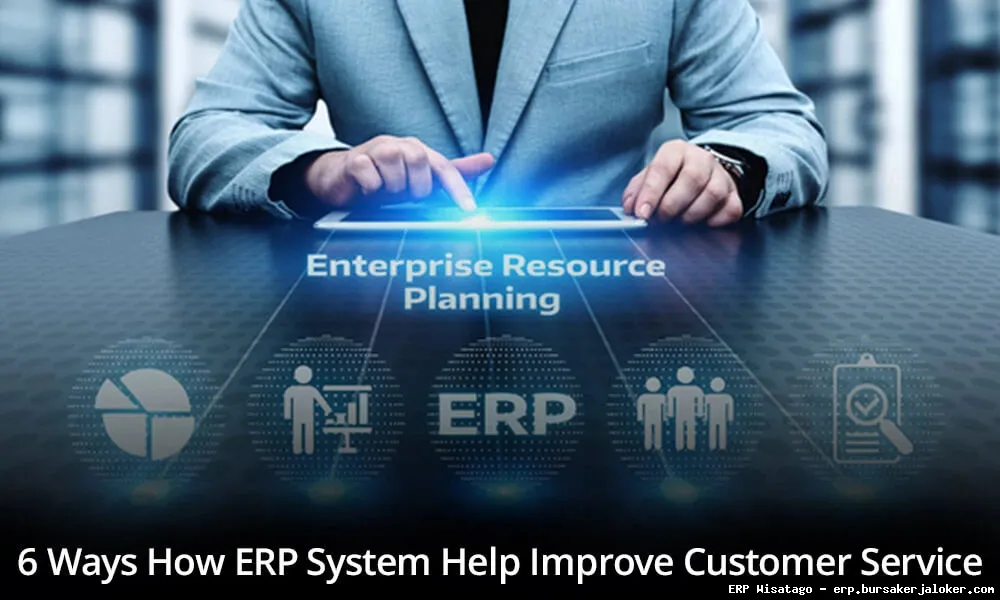In today’s competitive landscape, providing exceptional customer service is no longer a luxury, it’s a necessity. Customers expect seamless experiences, personalized interactions, and quick resolutions to their issues. This demand puts immense pressure on businesses to streamline their operations and empower their customer service teams. One powerful tool that can significantly enhance customer service capabilities is an Enterprise Resource Planning (ERP) system.
ERP systems are often thought of as primarily for finance, manufacturing, or supply chain management. However, a well-implemented ERP can be a game-changer for customer service. By integrating various business functions and providing a centralized view of customer data, an ERP system enables customer service representatives to deliver faster, more informed, and more personalized support. This leads to increased customer satisfaction, loyalty, and ultimately, business growth.

This article will delve into the world of ERP for customer service, exploring its benefits, key features, implementation considerations, and how to choose the right solution for your specific needs. Having worked with several ERP implementations across diverse industries, I’ll share practical insights and lessons learned to help you navigate the complexities and maximize the value of your ERP investment for superior customer service.
What is ERP and How Does it Relate to Customer Service?
Enterprise Resource Planning (ERP) is a type of software system that integrates various business processes and functions into a single, unified platform. Think of it as the central nervous system of your organization, connecting departments like finance, human resources, manufacturing, supply chain, and, importantly, customer service. This integration eliminates data silos, streamlines workflows, and provides a holistic view of the business.
The relationship between ERP and customer service is centered around data and access. An ERP system consolidates all customer-related information – including contact details, purchase history, support tickets, interactions, and preferences – into a single, accessible database. This eliminates the need for customer service representatives to search through multiple systems to find the information they need, saving time and improving the accuracy of their responses.
Furthermore, ERP systems can automate various customer service processes, such as order tracking, warranty management, and returns processing. This automation reduces manual effort, minimizes errors, and ensures consistent service delivery across all channels.
Key Benefits of ERP for Customer Service
Implementing an ERP system can bring numerous benefits to your customer service operations:
- Improved Customer Experience: Faster response times, personalized interactions, and accurate information lead to a more positive customer experience.
- Increased Efficiency: Automation of tasks and streamlined workflows reduce manual effort and improve agent productivity.
- Enhanced Data Visibility: A centralized view of customer data enables agents to make informed decisions and provide tailored solutions.
- Better Collaboration: Seamless integration with other departments facilitates collaboration and ensures that all teams are aligned in their efforts to serve the customer.
- Reduced Costs: Increased efficiency, reduced errors, and improved customer retention contribute to lower operational costs.
- Improved Reporting and Analytics: ERP systems provide comprehensive reporting and analytics capabilities, allowing businesses to track customer service performance, identify trends, and make data-driven decisions.
Key Features of ERP for Customer Service
While the specific features offered by ERP systems vary depending on the vendor and the industry, some key features are particularly relevant to customer service:
Customer Relationship Management (CRM) Integration
CRM integration is arguably the most important feature of an ERP system for customer service. It provides a comprehensive view of the customer, including their contact information, purchase history, interactions, and preferences. This allows agents to personalize their interactions and provide tailored solutions.
Case Management
Case management functionality allows agents to track and manage customer inquiries, complaints, and support requests. This ensures that all issues are addressed promptly and effectively.
Knowledge Base
A knowledge base provides agents with access to a repository of information, including FAQs, troubleshooting guides, and product documentation. This helps them resolve customer issues quickly and accurately.
Self-Service Portal
A self-service portal allows customers to find answers to their questions and resolve issues on their own, without having to contact a customer service representative. This reduces the workload on agents and empowers customers to take control of their own support experience.
Order Management
Order management functionality allows agents to track orders, manage returns, and process refunds. This ensures that customers receive their orders on time and that any issues are resolved quickly and efficiently.
Warranty Management
Warranty management functionality allows agents to track warranties, process claims, and provide support for products under warranty. This ensures that customers receive the support they need for their products.
Service Scheduling
Service scheduling functionality allows agents to schedule service appointments for customers. This ensures that customers receive timely and efficient service for their products.
Reporting and Analytics
Reporting and analytics capabilities provide businesses with insights into customer service performance, allowing them to identify areas for improvement and make data-driven decisions. Key metrics to track include resolution time, customer satisfaction, and agent productivity.
Implementing ERP for Customer Service: A Step-by-Step Guide
Implementing an ERP system is a significant undertaking, but following a structured approach can increase the chances of success. Here’s a step-by-step guide:
1. Define Your Needs and Requirements
Before you start looking at ERP systems, take the time to clearly define your needs and requirements. What are your biggest customer service challenges? What processes do you want to automate? What data do you need to track? The more specific you are, the easier it will be to find an ERP system that meets your needs. Create a detailed requirements document outlining your must-have and nice-to-have features.

2. Research and Evaluate ERP Systems
Once you have a clear understanding of your needs, start researching and evaluating different ERP systems. There are many different vendors to choose from, so it’s important to do your homework. Consider factors such as the system’s features, scalability, cost, and ease of use. Read reviews, attend demos, and talk to other businesses that have implemented similar systems. Don’t be afraid to ask tough questions.
3. Choose the Right ERP System
After you’ve evaluated several ERP systems, it’s time to choose the one that’s right for your business. Consider your budget, your technical capabilities, and your long-term goals. Make sure the system is scalable and can grow with your business. Also, think about the vendor’s support and training offerings. A good vendor will provide comprehensive training and support to help you get the most out of your ERP system.
4. Plan and Prepare for Implementation
Implementation is a critical phase. Develop a detailed implementation plan that outlines the scope of the project, the timeline, and the resources required. Assemble a dedicated implementation team that includes representatives from different departments. Ensure that everyone is on board and understands their roles and responsibilities. Data migration is a crucial aspect, so plan how you will transfer data from your existing systems to the new ERP system.
5. Implement the ERP System
The implementation process can be complex and time-consuming. Work closely with the ERP vendor to ensure that the system is configured correctly and that all integrations are working properly. Conduct thorough testing to identify and resolve any issues before going live. Provide comprehensive training to your customer service team on how to use the new system. Remember, change management is key. Communicate the benefits of the new system to your team and address any concerns they may have.
6. Go Live and Monitor Performance
Once the ERP system is implemented, it’s time to go live. Monitor performance closely to identify any issues and make adjustments as needed. Collect feedback from your customer service team and use it to improve the system. Continuously evaluate the system’s performance and make adjustments as needed to ensure that it’s meeting your needs.
Common Challenges and How to Overcome Them
Implementing an ERP system is not without its challenges. Here are some common pitfalls and how to avoid them:
Lack of Clear Requirements
Challenge: Failing to define clear requirements can lead to choosing the wrong system or implementing it incorrectly.
Solution: Invest time in thoroughly analyzing your business processes and defining your needs and requirements. Involve stakeholders from all departments in the process.
Insufficient Training
Challenge: Lack of adequate training can lead to user resistance and underutilization of the system.
Solution: Provide comprehensive training to all users and offer ongoing support. Consider using a variety of training methods, such as online tutorials, classroom training, and one-on-one coaching.
Data Migration Issues
Challenge: Data migration can be complex and time-consuming, and errors can lead to inaccurate information and business disruptions.
Solution: Plan the data migration process carefully and ensure that the data is clean and accurate. Use data migration tools to automate the process and minimize errors.
Resistance to Change
Challenge: Users may resist the new system if they are not comfortable with it or if they fear that it will replace their jobs.
Solution: Communicate the benefits of the new system to users and address any concerns they may have. Involve users in the implementation process and provide them with opportunities to provide feedback.
Scope Creep
Challenge: Adding new features or functionalities during the implementation process can lead to delays and cost overruns.
Solution: Stick to the original scope of the project and avoid adding new features or functionalities unless they are absolutely necessary. Manage changes carefully and ensure that they are properly documented and approved.

Choosing the Right ERP System for Your Needs
Selecting the right ERP system is crucial for success. Here are some factors to consider:
- Industry Specificity: Does the ERP system cater to your specific industry? Industry-specific ERP solutions often have pre-built functionalities and best practices tailored to your business.
- Scalability: Can the system scale to meet your growing business needs? Choose a system that can accommodate your future growth and expansion.
- Integration Capabilities: Does the system integrate seamlessly with your existing systems? Integration is essential for ensuring that data flows smoothly between different departments.
- Cloud vs. On-Premise: Do you prefer a cloud-based or on-premise ERP system? Cloud-based systems offer greater flexibility and scalability, while on-premise systems provide more control over data security.
- Vendor Reputation and Support: Does the vendor have a good reputation and provide reliable support? Choose a vendor that has a proven track record and a strong commitment to customer service.
- Cost: What is the total cost of ownership, including software licenses, implementation services, and ongoing maintenance? Consider both the upfront costs and the long-term costs of the system.
Ultimately, the best ERP system for your business will depend on your specific needs and requirements. Take the time to carefully evaluate different options and choose a system that will help you improve your customer service and achieve your business goals.
Frequently Asked Questions (FAQ) about ERP for customer service
How can an Enterprise Resource Planning (ERP) system specifically improve the efficiency of my customer service team?
An ERP system significantly enhances customer service efficiency by centralizing data and automating key processes. By integrating information from sales, inventory, shipping, and finance, customer service representatives gain a 360-degree view of each customer interaction. This allows them to quickly access order history, track shipments, check inventory availability, and resolve billing inquiries without switching between multiple systems. Automation features, such as automated order updates and self-service portals, further reduce the workload on customer service teams, enabling them to focus on more complex issues and provide personalized support. Ultimately, ERP systems empower customer service teams to deliver faster, more accurate, and more satisfying customer experiences, leading to increased customer loyalty and retention.
What are the key features to look for in an ERP system to ensure excellent customer service support and responsiveness?
When selecting an ERP system for customer service, several key features are crucial for ensuring excellent support and responsiveness. A robust Customer Relationship Management (CRM) module is essential for managing customer interactions and tracking communication history. Look for features like case management, knowledge base integration, and service level agreement (SLA) management. Real-time inventory visibility is vital for accurately informing customers about product availability and delivery times. Furthermore, the system should offer seamless integration with communication channels such as email, phone, and chat, enabling omnichannel support. Finally, reporting and analytics capabilities allow you to monitor customer service performance, identify areas for improvement, and measure the impact of your customer service initiatives. A user-friendly interface and mobile accessibility are also important for empowering customer service representatives to provide efficient support from anywhere. Effective IT management often involves remote monitoring and maintenance, and understanding the nuances of RMM can be crucial for optimizing operational efficiency
.
How does integrating an ERP system with a customer service portal benefit both my customer service agents and my customers directly?
Integrating an ERP system with a customer service portal offers significant benefits for both customer service agents and customers. For agents, the integration provides access to real-time data from across the organization, including order information, inventory levels, and shipping status, directly within the customer service interface. This eliminates the need to switch between multiple systems, streamlining workflows and reducing response times. Customers benefit from self-service capabilities, such as order tracking, knowledge base access, and the ability to submit support requests online. By empowering customers to resolve simple issues independently, the integration reduces the volume of inquiries handled by agents, allowing them to focus on more complex and urgent cases. This leads to increased customer satisfaction, reduced support costs, and improved agent productivity. The unified system creates a seamless and efficient customer service experience for everyone involved, fostering stronger customer relationships and improved business performance. The data from the ERP helps personalize the portal experience.
